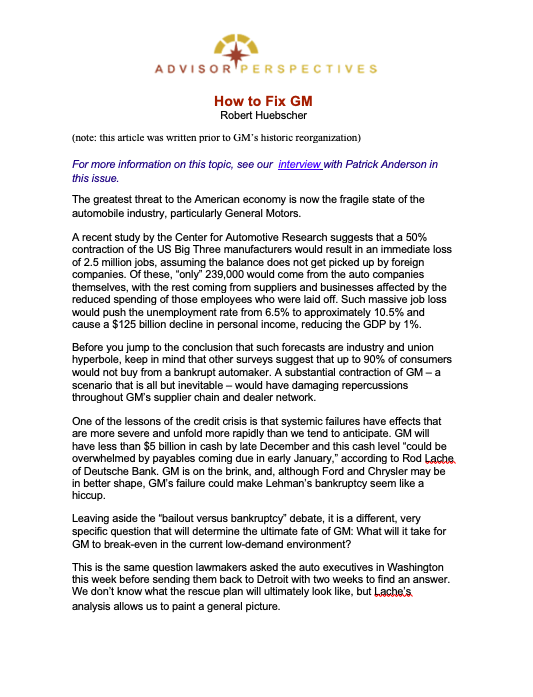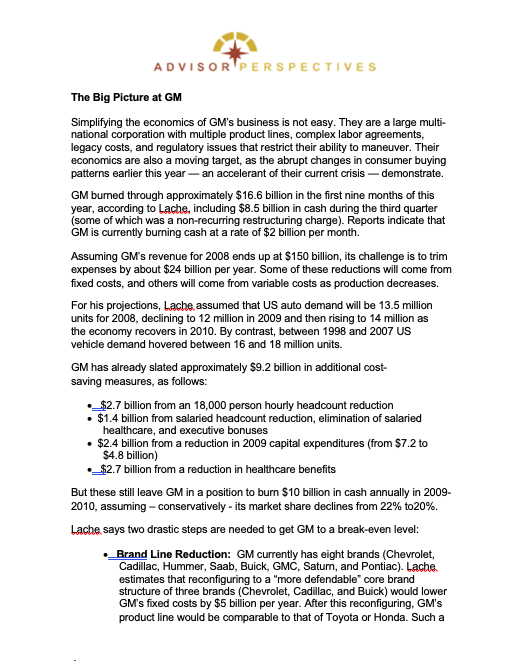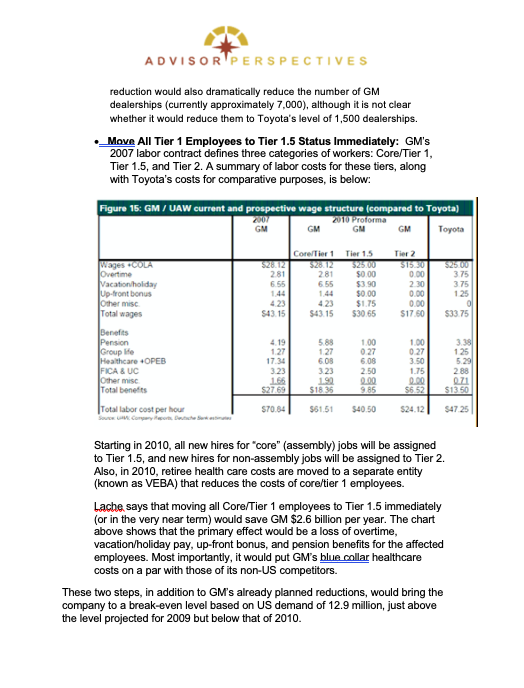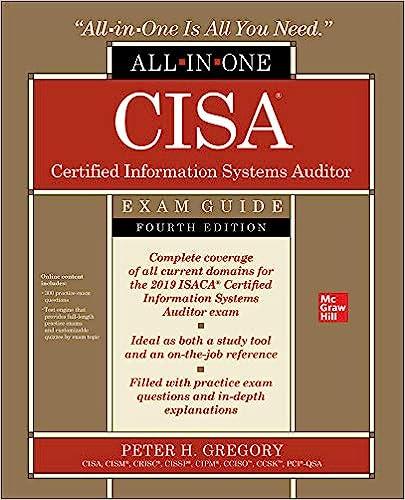




ADVISORTPERSPECTIVES How to Fix GM Robert Huebscher (note: this article was written prior to GM's historic reorganization) For more information on this topic, see our interview with Patrick Anderson in this issue. The greatest threat to the American economy is now the fragile state of the automobile industry, particularly General Motors. A recent study by the Center for Automotive Research suggests that a 50% contraction of the US Big Three manufacturers would result in an immediate loss of 2.5 million jobs, assuming the balance does not get picked up by foreign companies. Of these, "only' 239,000 would come from the auto companies themselves, with the rest coming from suppliers and businesses affected by the reduced spending of those employees who were laid off. Such massive job loss would push the unemployment rate from 6.5% to approximately 10.5% and cause a $125 billion decline in personal income, reducing the GDP by 1%. Before you jump to the conclusion that such forecasts are industry and union hyperbole, keep in mind that other surveys suggest that up to 90% of consumers would not buy from a bankrupt automaker. A substantial contraction of GM-a scenario that is all but inevitable - would have damaging repercussions throughout GM's supplier chain and dealer network. One of the lessons of the credit crisis is that systemic failures have effects that are more severe and unfold more rapidly than we tend to anticipate. GM will have less than $5 billion in cash by late December and this cash level "could be overwhelmed by payables coming due in early January, according to Rod Lache of Deutsche Bank. GM is on the brink, and, although Ford and Chrysler may be in better shape, GM's failure could make Lehman's bankruptcy seem like a hiccup Leaving aside the "bailout versus bankruptcy debate, it is a different, very specific question that will determine the ultimate fate of GM: What will it take for GM to break-even in the current low-demand environment? This is the same question lawmakers asked the auto executives in Washington this week before sending them back to Detroit with two weeks to find an answer. We don't know what the rescue plan will ultimately look like, but Lache's analysis allows us to paint a general picture. ADVISOR'PERSPECTIVES The Big Picture at GM Simplifying the economics of GM's business is not easy. They are a large multi- national corporation with multiple product lines, complex labor agreements, legacy costs, and regulatory issues that restrict their ability to maneuver. Their economics are also a moving target, as the abrupt changes in consumer buying patterns earlier this year an accelerant of their current crisis demonstrate. GM burned through approximately $16.6 billion in the first nine months of this year, according to Lache, including $8.5 billion in cash during the third quarter (some of which was a non-recurring restructuring charge). Reports indicate that GM is currently burning cash at a rate of $2 billion per month. Assuming GM's revenue for 2008 ends up at $150 billion, its challenge is to trim expenses by about $24 billion per year. Some of these reductions will come from fixed costs, and others will come from variable costs as production decreases For his projections, Lache assumed that US auto demand will be 13.5 million units for 2008, declining to 12 million in 2009 and then rising to 14 million as the economy recovers in 2010. By contrast, between 1998 and 2007 US vehicle demand hovered between 16 and 18 million units. GM has already slated approximately $9.2 billion in additional cost- saving measures, as follows: $2.7 billion from an 18,000 person hourly headcount reduction $1.4 billion from salaried headcount reduction, elimination of salaried healthcare, and executive bonuses $2.4 billion from a reduction in 2009 capital expenditures (from $7.2 to $4.8 billion) $2.7 billion from a reduction in healthcare benefits But these still leave GM in a position to burn $10 billion in cash annually in 2009. 2010, assuming-conservatively-its market share declines from 22% to 20% Lache says two drastic steps are needed to get GM to a break-even level: Brand Line Reduction: GM currently has eight brands (Chevrolet, Cadillac, Hummer, Saab, Buick, GMC, Satum, and Pontiac). Lache estimates that reconfiguring to a "more defendable core brand structure of three brands (Chevrolet, Cadillac, and Buick) would lower GM's foxed costs by $5 billion per year. After this reconfiguring, GM's product line would be comparable to that of Toyota or Honda. Such a ADVISOR PERSPECTIVES reduction would also dramatically reduce the number of GM dealerships (currently approximately 7,000), although it is not clear whether it would reduce them to Toyota's level of 1,500 dealerships. Move All Tier 1 Employees to Tier 1.5 Status Immediately: GM's 2007 labor contract defines three categories of workers: Core/Tier 1, Tier 1.5, and Tier 2. A summary of labor costs for these tiers, along with Toyota's costs for comparative purposes, is below: Figure 15: GM/UAW current and prospective wage structure compared to Toyota) 2010 Proforma GM GM G M Toyota Tier 15 Tier 1 530 520 281 wages COLA Overtime Vacation holiday Upfront bonus Core/tiert 222 281 6.55 144 423 $43.15 230 50 00 $3.90 $0.00 $1.75 $30.65 0.00 Others Total wages 423 S43.15 0.00 $17.50 533 75 419 588 100 Benefits Pension Group Healthcare OPEB FICA & UC Otherwise Total benefits 127 1734 323 16 $27.691 127 603 323 199 518 35 1.00 0.27 6.08 250 021 3.50 1.75 Total labor cost per hour 570.541 $51.51 $40.50 S24.121 547 25 Starting in 2010, all new hires for "core" (assembly) jobs will be assigned to Tier 1.5, and new hires for non-assembly jobs will be assigned to Tier 2. Also, in 2010, retiree health care costs are moved to a separate entity (known as VEBA) that reduces the costs of core/tier 1 employees. Lache says that moving all Core/Tier 1 employees to Tier 1.5 immediately (or in the very near term) would save GM $2.6 billion per year. The chart above shows that the primary effect would be a loss of overtime, vacation holiday pay, up-front bonus, and pension benefits for the affected employees. Most importantly, it would put GM's blue collar healthcare costs on a par with those of its non-US competitors. These two steps, in addition to GM's already planned reductions, would bring the company to a break-even level based on US demand of 12.9 million, just above the level projected for 2009 but below that of 2010. ADVISOR PERSPECTIVES Implementing such a plan faces enormous challenges. Dealerships are protected by state laws and may require buyouts to close. The organizational challenges of a brand-line restructuring of such a magnitude would be unprecedented in American industry. One-time capital expenditures would be necessary for plant closures. GM's pension liabilities would have to be restructured and settled. Lache.pegs these costs at a minimum of $20-25 billion. But the greatest challenge would be the union concessions required to move all Tier 1 employees to Tier 1.5 status. The UAW will be asked to make additional concessions, beyond moving employees to Tier 1.5. GM must modify the work rules in its union contracts, which put the company at a severe disadvantage vis--vis its non-US competitors. These rules, for example, stipulate how many workers must perform certain functions. Worker hours are tied to production output; so when a certain number of vehicles are processed in a day, workers can go home. GM is thus prevented from speeding up its production line without paying workers overtime. GM's Jobs Bank program - which contains the perverse incentive of paying workers not to work-must also be eliminated. The sad reality is that blue collar workers bear virtually the entire brunt of these changes, even though GM's management failed to make these changes and are thus responsible. But no degree of leadership change can correct the economic imbalance destabilizing GM's business. Patrick Anderson, CEO and founder of Anderson Economic Group in East Lansing, MI, consults with all three automakers on the economics of their business. In an interview with Advisor Perspectives, he said, "There is a very profitable GM contained within the current edifice. However, getting from the GM of 2008 to the GM of 2010 is going to be very difficult." But it is not impossible. Bringing GM to break-even requires extreme and drastic changes. But allowing GM to continue on its current trajectory may be even more extreme and drastic. Some will say that these changes cannot happen. But that attitude is exactly what got GM to this precipice. Unless we want to permanently subsidize GM at the taxpayer's expense, a profitable GM of the future will look very different from the cash-burning GM of today. UPDATE The above article was written just prior to GM's reorganization. Since then, GM has eliminated or sold several divisions including Pontiac, Saab and Hummer. Recent results On February 24, 2011, General Motors reported its first full-year profit since 2004. It can carry forward previous losses to reduce tax liability on future earnings. It earned $4.7 billion in 2010. The Wall Street Journal estimated the tax break, including credits for costs related to pensions and other expenses can be worth as much as $45 billion over the next 20 years. Chapter 11 reorganization GM had filed for Chapter 11 reorganization on June 8, 2009. On July 10. 2009. General Motors emerged from Chapter 11 reorganization. Shell The Company was listed on the New York Stock Exchange and the Toronto Stock Exchange again on November 18, 2010 following a US$33-a-share initial public offering of US$23 billion, including preferred shares. The shareholding in the Company by the U.S. Treasury department is reduced from about 61% to about 33%, including preferred shares and accounting for stock options given to former GM bondholders.263 Disposal of such shares gave the Treasury department about US$13.6 billion in proceeds. It was previously estimated that the Treasury has to sell GM shares at an average of $43.67 a share to break even. SAIC Motor, partner of GM in China and India, acquired just less than 1 percent of the new GM for about $500 million. Discussion Board Questions: 1) Based upon your knowledge of Cost-Volume-Profit analysis (break even). how did GM's actions contribute towards lowering its breakeven point (consider all items that influence breakeven)? It is suggested that you first identify selected costs as either variable or fixed. 2) How does lowering its break even point benefit GM, strategically as a company? 3) Analyze Figure 15 (comparative manufacturing labor costs between GM and Toyota). This analysis is a "before and after comparison of possible negotiated labor structures. "Pro-forma" is Greek for "what if" and is typically used as a term to identify future projections (this article was written prior to 2010) Why might it actually be in the union's benefit to agree to a labor cost tier other than the more expensive "Tier 1" (the original pre-2008 labor agreement)? 4) While some view the bailout of GM as somewhat controversial, due to the scope of the government's intervention, nevertheless the auto industry is still an important major industry in the U.S. and GM is its largest player. List some implicit considerations regarding why it is important for GM to be successful. ADVISORTPERSPECTIVES How to Fix GM Robert Huebscher (note: this article was written prior to GM's historic reorganization) For more information on this topic, see our interview with Patrick Anderson in this issue. The greatest threat to the American economy is now the fragile state of the automobile industry, particularly General Motors. A recent study by the Center for Automotive Research suggests that a 50% contraction of the US Big Three manufacturers would result in an immediate loss of 2.5 million jobs, assuming the balance does not get picked up by foreign companies. Of these, "only' 239,000 would come from the auto companies themselves, with the rest coming from suppliers and businesses affected by the reduced spending of those employees who were laid off. Such massive job loss would push the unemployment rate from 6.5% to approximately 10.5% and cause a $125 billion decline in personal income, reducing the GDP by 1%. Before you jump to the conclusion that such forecasts are industry and union hyperbole, keep in mind that other surveys suggest that up to 90% of consumers would not buy from a bankrupt automaker. A substantial contraction of GM-a scenario that is all but inevitable - would have damaging repercussions throughout GM's supplier chain and dealer network. One of the lessons of the credit crisis is that systemic failures have effects that are more severe and unfold more rapidly than we tend to anticipate. GM will have less than $5 billion in cash by late December and this cash level "could be overwhelmed by payables coming due in early January, according to Rod Lache of Deutsche Bank. GM is on the brink, and, although Ford and Chrysler may be in better shape, GM's failure could make Lehman's bankruptcy seem like a hiccup Leaving aside the "bailout versus bankruptcy debate, it is a different, very specific question that will determine the ultimate fate of GM: What will it take for GM to break-even in the current low-demand environment? This is the same question lawmakers asked the auto executives in Washington this week before sending them back to Detroit with two weeks to find an answer. We don't know what the rescue plan will ultimately look like, but Lache's analysis allows us to paint a general picture. ADVISOR'PERSPECTIVES The Big Picture at GM Simplifying the economics of GM's business is not easy. They are a large multi- national corporation with multiple product lines, complex labor agreements, legacy costs, and regulatory issues that restrict their ability to maneuver. Their economics are also a moving target, as the abrupt changes in consumer buying patterns earlier this year an accelerant of their current crisis demonstrate. GM burned through approximately $16.6 billion in the first nine months of this year, according to Lache, including $8.5 billion in cash during the third quarter (some of which was a non-recurring restructuring charge). Reports indicate that GM is currently burning cash at a rate of $2 billion per month. Assuming GM's revenue for 2008 ends up at $150 billion, its challenge is to trim expenses by about $24 billion per year. Some of these reductions will come from fixed costs, and others will come from variable costs as production decreases For his projections, Lache assumed that US auto demand will be 13.5 million units for 2008, declining to 12 million in 2009 and then rising to 14 million as the economy recovers in 2010. By contrast, between 1998 and 2007 US vehicle demand hovered between 16 and 18 million units. GM has already slated approximately $9.2 billion in additional cost- saving measures, as follows: $2.7 billion from an 18,000 person hourly headcount reduction $1.4 billion from salaried headcount reduction, elimination of salaried healthcare, and executive bonuses $2.4 billion from a reduction in 2009 capital expenditures (from $7.2 to $4.8 billion) $2.7 billion from a reduction in healthcare benefits But these still leave GM in a position to burn $10 billion in cash annually in 2009. 2010, assuming-conservatively-its market share declines from 22% to 20% Lache says two drastic steps are needed to get GM to a break-even level: Brand Line Reduction: GM currently has eight brands (Chevrolet, Cadillac, Hummer, Saab, Buick, GMC, Satum, and Pontiac). Lache estimates that reconfiguring to a "more defendable core brand structure of three brands (Chevrolet, Cadillac, and Buick) would lower GM's foxed costs by $5 billion per year. After this reconfiguring, GM's product line would be comparable to that of Toyota or Honda. Such a ADVISOR PERSPECTIVES reduction would also dramatically reduce the number of GM dealerships (currently approximately 7,000), although it is not clear whether it would reduce them to Toyota's level of 1,500 dealerships. Move All Tier 1 Employees to Tier 1.5 Status Immediately: GM's 2007 labor contract defines three categories of workers: Core/Tier 1, Tier 1.5, and Tier 2. A summary of labor costs for these tiers, along with Toyota's costs for comparative purposes, is below: Figure 15: GM/UAW current and prospective wage structure compared to Toyota) 2010 Proforma GM GM G M Toyota Tier 15 Tier 1 530 520 281 wages COLA Overtime Vacation holiday Upfront bonus Core/tiert 222 281 6.55 144 423 $43.15 230 50 00 $3.90 $0.00 $1.75 $30.65 0.00 Others Total wages 423 S43.15 0.00 $17.50 533 75 419 588 100 Benefits Pension Group Healthcare OPEB FICA & UC Otherwise Total benefits 127 1734 323 16 $27.691 127 603 323 199 518 35 1.00 0.27 6.08 250 021 3.50 1.75 Total labor cost per hour 570.541 $51.51 $40.50 S24.121 547 25 Starting in 2010, all new hires for "core" (assembly) jobs will be assigned to Tier 1.5, and new hires for non-assembly jobs will be assigned to Tier 2. Also, in 2010, retiree health care costs are moved to a separate entity (known as VEBA) that reduces the costs of core/tier 1 employees. Lache says that moving all Core/Tier 1 employees to Tier 1.5 immediately (or in the very near term) would save GM $2.6 billion per year. The chart above shows that the primary effect would be a loss of overtime, vacation holiday pay, up-front bonus, and pension benefits for the affected employees. Most importantly, it would put GM's blue collar healthcare costs on a par with those of its non-US competitors. These two steps, in addition to GM's already planned reductions, would bring the company to a break-even level based on US demand of 12.9 million, just above the level projected for 2009 but below that of 2010. ADVISOR PERSPECTIVES Implementing such a plan faces enormous challenges. Dealerships are protected by state laws and may require buyouts to close. The organizational challenges of a brand-line restructuring of such a magnitude would be unprecedented in American industry. One-time capital expenditures would be necessary for plant closures. GM's pension liabilities would have to be restructured and settled. Lache.pegs these costs at a minimum of $20-25 billion. But the greatest challenge would be the union concessions required to move all Tier 1 employees to Tier 1.5 status. The UAW will be asked to make additional concessions, beyond moving employees to Tier 1.5. GM must modify the work rules in its union contracts, which put the company at a severe disadvantage vis--vis its non-US competitors. These rules, for example, stipulate how many workers must perform certain functions. Worker hours are tied to production output; so when a certain number of vehicles are processed in a day, workers can go home. GM is thus prevented from speeding up its production line without paying workers overtime. GM's Jobs Bank program - which contains the perverse incentive of paying workers not to work-must also be eliminated. The sad reality is that blue collar workers bear virtually the entire brunt of these changes, even though GM's management failed to make these changes and are thus responsible. But no degree of leadership change can correct the economic imbalance destabilizing GM's business. Patrick Anderson, CEO and founder of Anderson Economic Group in East Lansing, MI, consults with all three automakers on the economics of their business. In an interview with Advisor Perspectives, he said, "There is a very profitable GM contained within the current edifice. However, getting from the GM of 2008 to the GM of 2010 is going to be very difficult." But it is not impossible. Bringing GM to break-even requires extreme and drastic changes. But allowing GM to continue on its current trajectory may be even more extreme and drastic. Some will say that these changes cannot happen. But that attitude is exactly what got GM to this precipice. Unless we want to permanently subsidize GM at the taxpayer's expense, a profitable GM of the future will look very different from the cash-burning GM of today. UPDATE The above article was written just prior to GM's reorganization. Since then, GM has eliminated or sold several divisions including Pontiac, Saab and Hummer. Recent results On February 24, 2011, General Motors reported its first full-year profit since 2004. It can carry forward previous losses to reduce tax liability on future earnings. It earned $4.7 billion in 2010. The Wall Street Journal estimated the tax break, including credits for costs related to pensions and other expenses can be worth as much as $45 billion over the next 20 years. Chapter 11 reorganization GM had filed for Chapter 11 reorganization on June 8, 2009. On July 10. 2009. General Motors emerged from Chapter 11 reorganization. Shell The Company was listed on the New York Stock Exchange and the Toronto Stock Exchange again on November 18, 2010 following a US$33-a-share initial public offering of US$23 billion, including preferred shares. The shareholding in the Company by the U.S. Treasury department is reduced from about 61% to about 33%, including preferred shares and accounting for stock options given to former GM bondholders.263 Disposal of such shares gave the Treasury department about US$13.6 billion in proceeds. It was previously estimated that the Treasury has to sell GM shares at an average of $43.67 a share to break even. SAIC Motor, partner of GM in China and India, acquired just less than 1 percent of the new GM for about $500 million. Discussion Board Questions: 1) Based upon your knowledge of Cost-Volume-Profit analysis (break even). how did GM's actions contribute towards lowering its breakeven point (consider all items that influence breakeven)? It is suggested that you first identify selected costs as either variable or fixed. 2) How does lowering its break even point benefit GM, strategically as a company? 3) Analyze Figure 15 (comparative manufacturing labor costs between GM and Toyota). This analysis is a "before and after comparison of possible negotiated labor structures. "Pro-forma" is Greek for "what if" and is typically used as a term to identify future projections (this article was written prior to 2010) Why might it actually be in the union's benefit to agree to a labor cost tier other than the more expensive "Tier 1" (the original pre-2008 labor agreement)? 4) While some view the bailout of GM as somewhat controversial, due to the scope of the government's intervention, nevertheless the auto industry is still an important major industry in the U.S. and GM is its largest player. List some implicit considerations regarding why it is important for GM to be successful











